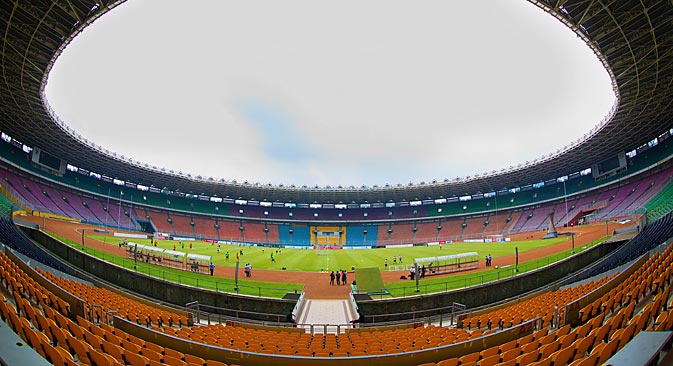Jakarta’s strong Soviet influence

Gelora Bung Karno Sports Complex, the largest and oldest mega sports facility in Indonesia. Source: Press photo
Exactly three years after the failed 1905 revolution in Russia, Indonesia had its Tahun Kebangkitan Bangsa or Year of National Awakening, which was the earliest precursor to the Indonesian Revolution and led to the country’s independence from Dutch colonisation. The country’s first president Soekarno saw many parallels between Indonesian independence from colonial rule and the peasants’ struggle and the overthrowing of the Romanovs in Russia and the subsequent developments in the Soviet Union. This translated into several monuments being built across Jakarta in the style of Soviet realism.
The Indonesian capital’s Patung Pemuda or Youth Monument is one of the finest examples of Soviet realism. The huge statue was erected to symbolise the contribution of youthful courage in the development of the country, much on the lines of ‘Komsomols,’ who were the building blocks of the USSR. The monument depicts a bare-bodied and muscular peasant holding a saucer containing an eternal flame, which represents the eternal spirit of youth. The statue stands on a two-metre pedestal and Jakartans see even more of the larger than life monument than the country’s first president would have intended, since it is on a busy street and the city’s nightmarish traffic jams force motorists to take notice!
Like in Russia, where some members of the youth now poke fun at Soviet-era monuments, the symbol of eternal youth is often affectionately referred to as the “Pizza Man.” It goes without say that globalisation and multinationals have planted their feet firmly on the country.
The Tugu Tani or Heroes Statue, which depicts an Indonesian independence fighter who is ready to take on the Dutch colonisers to free his country, along with his supportive mother, is the city’s strongest connection to Russia. The monument, which is close to Jakarta’s Gambir railway station, is probably the most famous work of prominent Russian sculptor Matvey Manizer in Asia.
The statue came into being after Soekarno requested Manizer and his son Otto to build a monument to commemorate Indonesia’s freedom struggle. The Manizer family visited Java in the early 1960s, where they heard the story of a mother who supported her son in fighting for his country, but told him to always remember his parents. The bronze statue was made in Communist style (complete with a peasant holding a gun) and sent as a gift to Indonesia. There are traces of Russia even in the flower beds that surround the statue and in the tropical heat on Jakarta one gets the feeling of being by a small Russian square. An inscription in Bahasa at the pedestal of the monument reads: “Only a nation that respects its heroes can become a great nation.”
Soekarno also admired the Soviet Union for winning the Space Race and wanted Indonesia to have an advanced aeronautical industry. The 11-meter bronze Pancoran statue in southern Jakarta depicts a man pointing north in the direction of the city’s first airport. The idea was to depict the nation’s glory in aviation.
Jakarta’s most famous landmark, the 132-metre high Monas (National Monument), which is dubbed “Soekarno’s final erection” has a series of reliefs surrounding the base of the tower. These reliefs, made from molded cement, depict Indonesia’s freedom struggle and independence and were designed to inspire the masses, much like the public art works in the Soviet Union that depict history and give a political narrative.
Monas and the Merdeka Square where it’s located hold essentially the same value for Indonesia as the Kremlin and Red Square do for Russia. Although the Indonesian monument is not ancient or aesthetically pleasing, the seat of power in the large country is just a stone’s throw away. Like the Red Square, which usually has more tourists and visitors than Muscovites, the Merdeka Square is a great place to actually see the diversity of Indonesia and hear its dialects and lesser spoken languages as it’s a magnet for visitors from across the country.
Jakarta’s own Luzhniki
The Russian and Soviet connection in Jakarta goes beyond the city’s large statues and monuments. The Gelora Bung Karno Sports Complex, which is the largest and oldest mega sports facility in Indonesia, was partially financed by the Soviet Union. The complex was built for the 1962 Asian Games and its main stadium, which originally had a capacity of over 100,000, resembles Moscow’s Luzhniki Stadium.
Soekarno delivered a speech at the Luzhniki in 1956 and was believed to be so impressed with the stadium that he decided that the Indonesian capital needed a similar sports complex. The USSR extended a special loan of $12.5 million for the complex and Soviet architects and builders were engaged in the construction of the facility, which is still one of the largest in all of Southeast Asia.
Russia and Indonesia has moved on from the days of Socialism but traces of the past remain an essential part of the landscape of both their capitals.
Read more: Russia to compete with China and South Korea for Indonesian market>>>
All rights reserved by Rossiyskaya Gazeta.
Subscribe
to our newsletter!
Get the week's best stories straight to your inbox